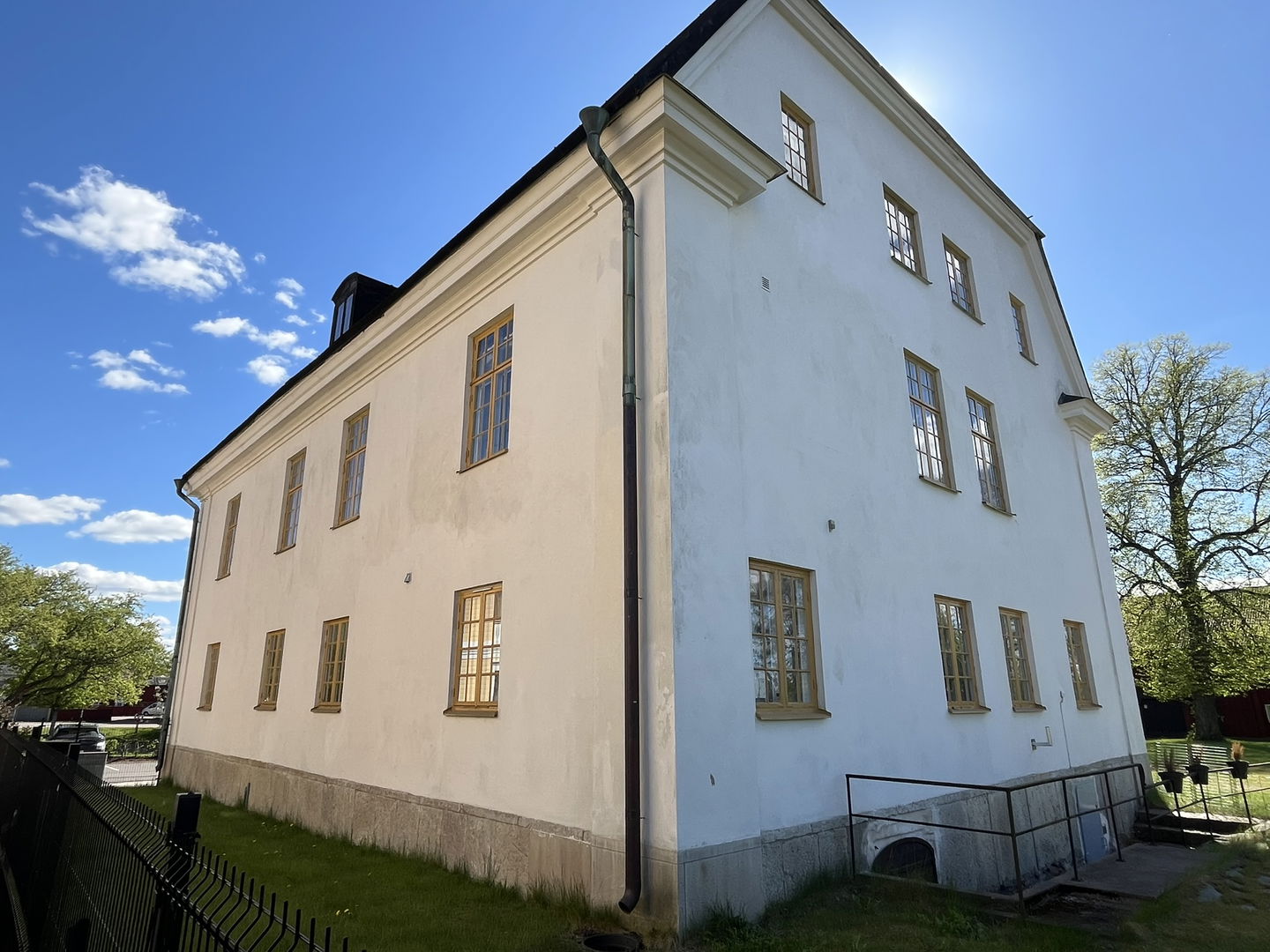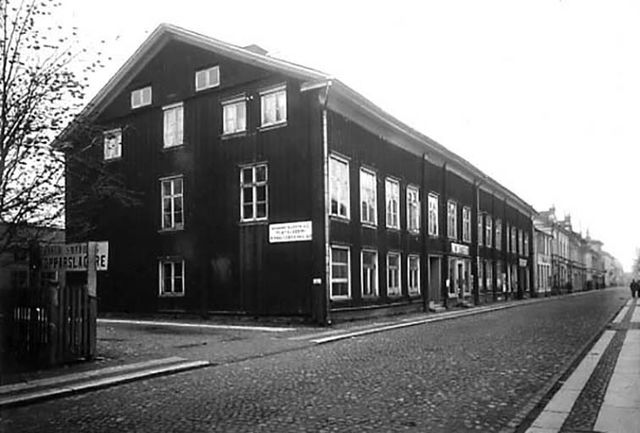
Architecture Walk 3 in Kristinehamn
Walking
- County: Värmlands län
- 6708.18 km away from you
Trail details
- Length 1.3 km
- Difficulty Green - simple
Actions
Description
From the Stone Age of the Town to the Steel Bridge
Set out on a journey through urban development—from the first stone houses to contemporary architecture and modern bridge construction.
Kristinehamn has many exciting, beautiful, and interesting buildings. On this walk, we will tell you more in-depth stories about some of them. Keep an eye out for other beautiful buildings, bridges, and sculptures throughout your walk. Some have small silver plaques with interesting information—don’t miss them! There are also oval signs with complementary stories at several locations. The walk starts on Kungsgatan at Södra Torget and continues south along Kungsgatan. Enjoy your tour!
A.G. Petersson’s House, Kungsgatan 31 – Piled Security
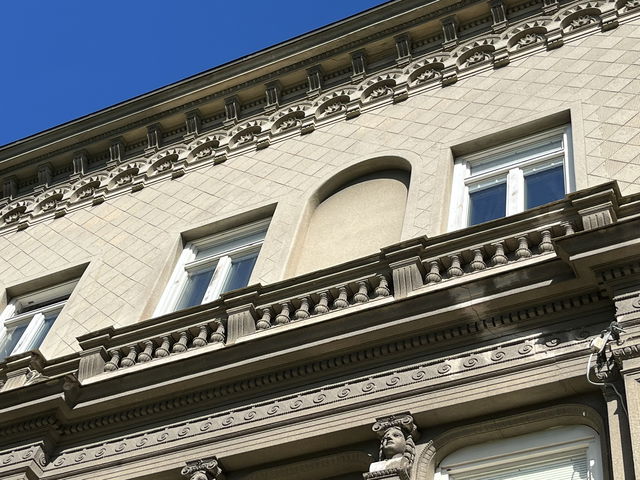
After the fire of 1893, which destroyed the entire main shopping street (Kungsgatan), the street was widened and buildings were constructed in stone.
Architect Carl Österman designed Kungsgatan 31 with distinct horizontal moldings, built on a sturdy piled foundation. The neighboring corner house, also known as Kjellman’s Corner, was not built on piles and sank so much that the lowest step disappeared! That building had to be demolished, but A.G. Petersson’s property remains solid today and is sometimes called “Tidningspelles hus” (The Newspaper Pete’s House) because the Kristinehamn newspaper’s editorial office was once located here.
The House with Restaurant Oliveriet, Kungsgatan 48 – The House of Delicacies
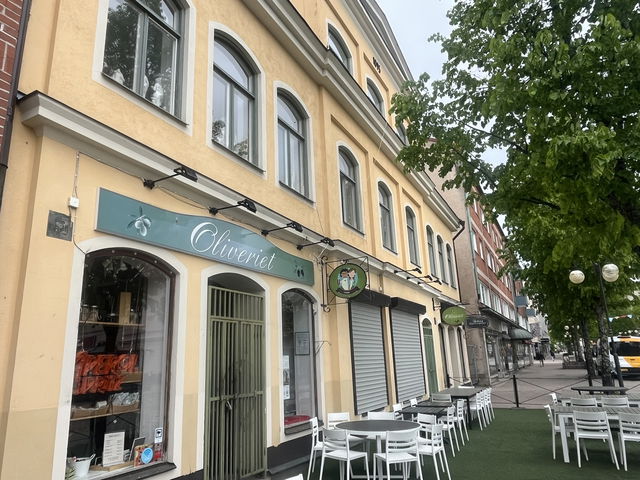
This building was completed in 1895 and proudly displays its construction year on the facade. It once housed Pettersson’s confectionery—famous for its beautifully lavish interior and delicious sweets. According to rumors, parts of the original decor remain hidden behind newer walls. It is said that potatoes were once grown on the adjacent plot!
Today, you can enjoy Italian delicacies at the restaurant.
In the pavement in front of the house, slightly to the north, you can see a “bojort” (a type of sailing ship) with billowing sails in cobblestones. A nod to the bojort included in Kristinehamn’s city coat of arms, which was created when Queen Christina granted the town its city privileges in 1642.
The Salvation Army’s Fortress, Spelmansgatan 23 – An English Castle in the Middle of the Shopping Street
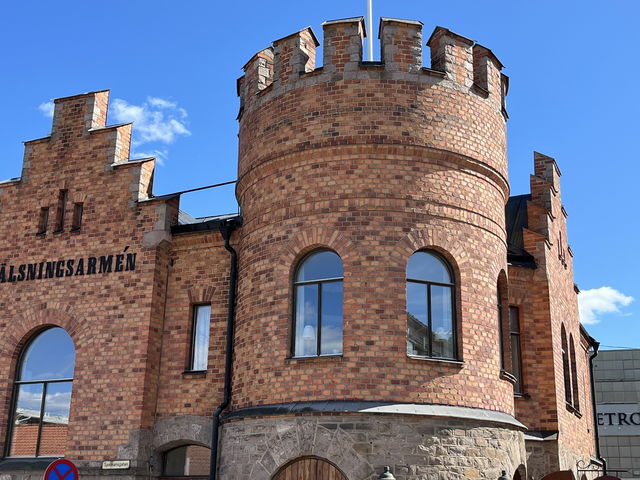
After the 1893 fire, the Salvation Army built a new stone building—for safety’s sake. The result was a building in Scottish medieval style, with stepped gables and small “towers” with battlements. This style was popular with the English middle class at the time. The building truly has the character of a secure little fortress.
Since 1977, it has housed modern meeting facilities and a café within its sturdy walls.
Park Bridge, Between Vågen Block and City Park – Award-Winning Steel in the Iron Harbor

At the site where the bridge was built, old wooden piles were found, probably from the 19th-century iron harbor. The discovery delayed construction somewhat, but the bridge was inaugurated in summer 2020. Many locals had opinions about its design and style, but outside the municipality, it has received great acclaim and was named Sweden’s best steel project in 2021. The bridge also competed internationally.
The bridge beautifully connects the guest harbor and the city center—and with its 48 bridges, Kristinehamn remains one of Central Sweden’s most bridge-dense municipalities.
Sjötullen, Hovslagaregatan 6 – Customs and Lawyers

The name recalls the old customs house that stood closer to the river, where goods were unloaded—not least spirits, as the spirit warehouse was located nearby.
The current building was constructed after the fire of 1804 in a style called Swedish Classicism. The builder was Johan Carl Gerneij, a lawyer and member of the Royal Swedish Academy of Sciences. He was also director of all cast iron blowing.
The property consists of several buildings, and the one facing Hovslagaregatan has an oil-colored street facade and a traditional red courtyard facade—demonstrating a classic way to save money: a fine exterior, simpler interior. Several houses in Kristinehamn have two facade colors—keep an eye out.
Nordenfeldt House, Norra Hamngatan 8 – Royalty and the Poor
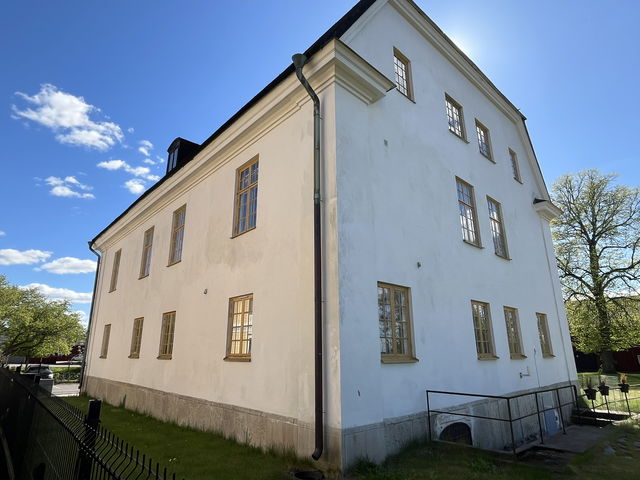
Kristinehamn’s oldest stone house is a true historical gem! It was built by Regina Nordenfeldt in 1771 after the previous wooden building was destroyed by fire.
On the same site, Duke Karl built a royal estate as early as the 1570s. Some old vaults in the basement may date back to that time.
Once home to the town’s elite, it later became a poorhouse. Today, the house is carefully renovated by private owners.
With its broken roof and hipped gable ends, the house has withstood both fires and the ravages of time.
Wahlundgården, Västerlånggatan 22 – Haunted House

A property with many lives: first built in the 1600s, burned down in 1777, rebuilt, then burned again in 1804. The current house was rebuilt in 1806. Eventually, Gustaf Wahlund acquired the property and had the house clad in boards and adorned with both balcony and frontispiece.
It is said to be haunted! An Indian princess is said to have been kept in a chest in the attic, supposedly placed there by a man who worked for the East India Company.
The house was saved from demolition in the 1960s and now stands proudly with a new slate roof from 2004—a roof hoped to last another 200 years.
Torgkällan, Södra Torget – The City’s Gathering Place

In the 1800s, the water in the spring was poor quality—but in 1847, confectioner P.G. Lundgren took matters into his own hands. He had a water pipeline built from the Kullkällan spring to the square using hollowed-out logs. A technical marvel!
In 1881, Torgkällan received its current appearance, and another marvel was installed—a modern steam-powered pump donated by engineer Harald Asplund from Kristinehamn’s Mechanical Workshop. Torgkällan was the townspeople’s primary water source until the early 20th century. It was described at the time as having “three ejectors, which when you simply press a button instantly fill the vessel.”
It is believed that this pump is the one Gustaf Fröding wrote about in his poem “The Market Pump.”
Now you are back at Södra Torget. We hope you have enjoyed a lovely walk filled with many historical and architectural impressions.
Activities And Facilities
-
Walking
-
Culture trail
Accessibility
-
Near Public Transport
-
Stroller accessible
Contact
Address
+46 (0)550 88187
Email address
Kristinehamns turistbyrå
Organization logotype

Questions & Answers
Ask a question to other Naturkartan users.







